Growing beets in the open field: care rules for obtaining sweet and large root crops
So it turns out that along with carrots, novice summer residents often have problems with growing beets. Indeed, caring for root crops that grow underground is different from growing “aboveground” vegetables such as tomatoes and cucumbers.
However! Beets are certainly easier to grow than carrots, because they can be transplanted initially sow seedlings... And it does not attack carrot fly.
Next, you will receive all the basic information and recommendations on how to care for beets in the open field, so that the harvest will please you with both its quantity and quality, namely the sweetness of the root vegetables.
By the way! The site contains materials aboutwhen and how to sow beet seeds in open ground in spring andin autumn (before winter).
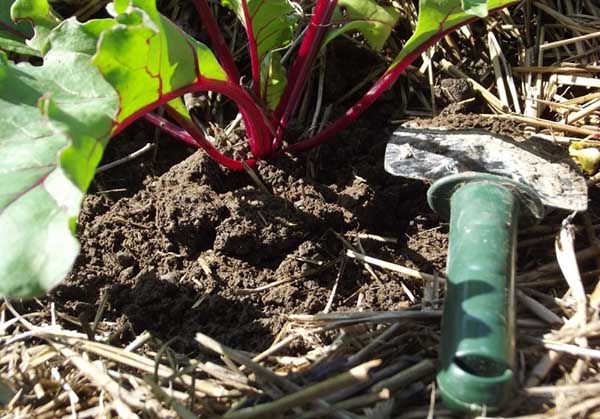
Content
Agricultural technology for growing beets in the open field: basic care measures
If the planting of beets was carried out correctly, then friendly shoots will appear already on the 4th-6th day.
How to care for beets further? Now you will find out everything.
Thinning
The need for thinning beets is explained by the fact that 2-3 sprouts often appear at once from one beet seed (therefore its seeds are also called "glomeruli"). In other words, if you do not thin it out, then it simply will not have enough space for normal development, and the roots will grow small.
By the way! There is also one-sprout beet (varieties Mona, Monica), which is always written on the package. It can be immediately planted at the required distance and no longer thinned out.
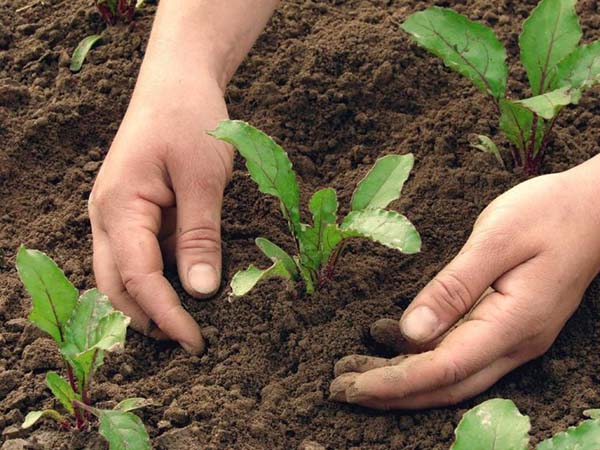
As a rule, beets are thinned in 2 stages (but you can also in 1):
Thin out beets are necessary only after watering (or rain) and preferably in cloudy weather.
- First time beets must be thinned out in the phase of the first 2-4 true leaves, when their height is about 8-10 centimeters. First of all, you need to remove the weakest plants and those that grow too close (and they do not have to be thrown away, you can simply transplant them to another bed). After the first thinning, the distance between the roots should remain within 3-5 centimeters.
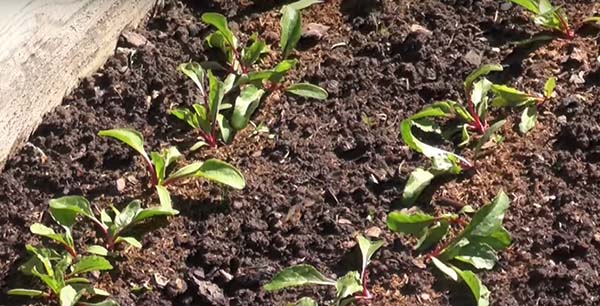
In principle, you can do with one thinning, immediately leaving only strong plants at a distance of 8-15 cm from each other.
- Second decimation is carried out in the phase of the initial formation of the root crop (i.e., around July, when the leaves are above 12-15 cm). A distance of about 8-10 centimeters should be left between the root crops (some growers even leave up to 15 cm: this way the beets will be larger), removing all densely growing plants and those that seem to you to be "wrong" or sick.
Advice! You can use thinned young root vegetables for food.
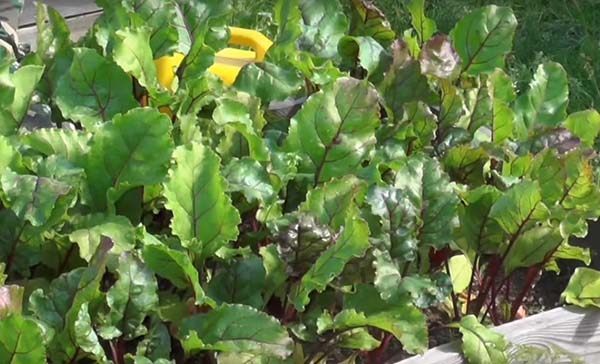
Think! However, large beets are not very convenient to use (for example, it is not recommended to cut them during cooking). So why is she so needed? Accordingly, you need to thin out wisely, without making too large distances between the plants so that they do not grow gigantic.
Watering
The first abundant watering of beets is usually done after the first thinning. Then you need to water about 1 time a week (5-7 days), i.e. infrequently. It's another matter if the July heat is on: during this period you need to water more often. It is worth stopping watering beets about 1-2 weeks before harvesting.
By the way! Beets can be watered by sprinkling, i.e. on top of the tops, so that the foliage receives moisture.
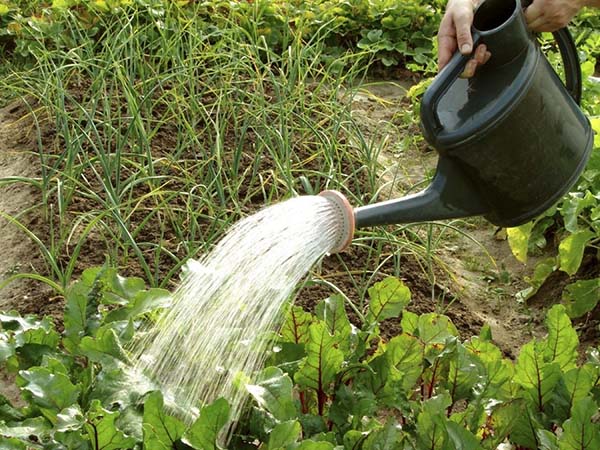
If the beets do not have enough moisture, then the fruits will grow small, coarse and tasteless.
However, if the beets form and develop a very long, thin root, they will be able to get to the moisture on their own (= extract themselves).
Mulching, loosening and weeding
Unlike carrots, beets are usually do not mulch.
However, in order to better retain moisture, you can slightly (in layers of 1-2 cm) mulch the aisles sawdust or peat.
Therefore, almost immediately after germination, you need loosen the aisles (even more so if it rains) so that the air flows well to the roots.
And promptly remove weeds... Root crops generally don't like growing in a competitive environment.
Advice! It is convenient to combine weeding with thinning.
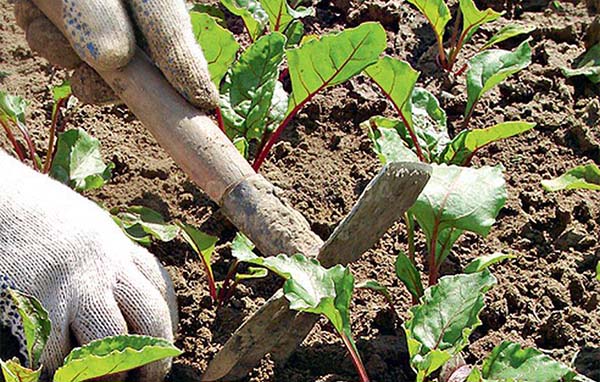
Top dressing
If you did not initially fill the soil with a sufficient amount of organic matter (in general, you did the right thing) and mineral fertilizers, then for the successful cultivation of beets you will need to feed it several times.
However! Beets, along with onions, are not very fond of excess organic matter and initially nitrogen-rich soils.
You can feed beets during the growing season according to the following scheme:
- First feeding (usually done after the formation of the first true leaves and the first thinning) — nitric... Most often, various organic infusions are used, for example, herbal, or infusion of mullein or chicken droppings.But you can also use mineral nitrogen fertilizers such as ammonium nitrate or urea... 1-2 dressings will be enough (after 7-10 days).
- The next feeding of beets is done only after how fruiting will begin (for example, after the second thinning, i.e. from about July). Now the plant needs more potassium, which means that the beets can be fed wood ash, potassium sulfate, or even potassium chloride and potassium salt. Moreover, such dressings can be done 2-3 (after 10-14 days), with the last one 3-4 weeks before harvest.
By the way! Beets are very loves alkaline soil, so the solution wood ash - this is an ideal feeding during the period of its growth (in addition to potassium, it contains phosphorus, as well as boron).
Also, beets perfectly tolerates chloride fertilizers, therefore, for potash feeding, you can use potassium chloride.
- Also, it will not be superfluous to make one phosphorus feeding, for example, infusion superphosphate (if you did not initially apply to the garden phosphate fertilizers).
And also beets are in great need in the pine forest... Therefore, you can perform foliar (by leaves) boron feeding, for example, with fertilizer "Mag-Bor" or with the help of "Boric acid". There is also such a complex mineral fertilizer as "Borofoska".

Note! Without enough bora the root vegetable may grow a hollow middle or the core will become dark (they also say "heart rot").
Than to water beets to make them sweeter
If you want the beets to be sweet, in order to increase its sugar content, you need to saturate the soil with sodium. For example, in early July you can 1 time water the beets with brine (at the rate of 1-2 tablespoons or 20-30 grams of table salt per 10 liters of water).
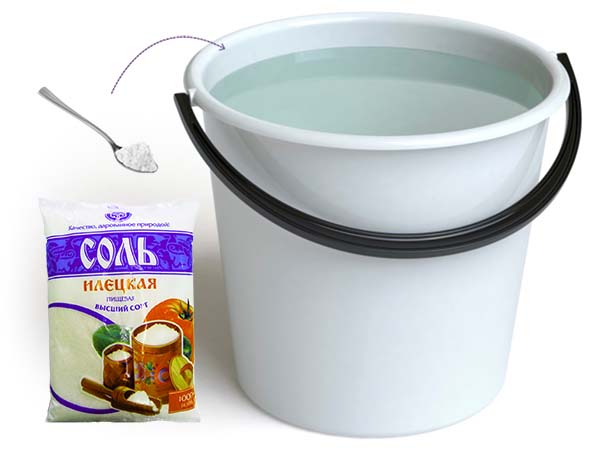
Idea! If you are downright afraid of soil salinization, then use soda - it also contains a lot of sodium. Better yet, feed Sodium humate.
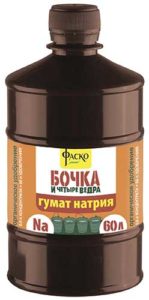
And do not forget that potassium (especially chloride) and boron also increase the sweetness and tenderness of root vegetables.
Problems with growing beets
- If the beets do not grow (develops poorly) and they leaves turn red (downright become burgundy), then, most likely, you have overly acidic soiland beets like alkaline. You can quickly deoxidize the soil, for example, by spilling it with an ash solution.
However! If you know that you have excessively acidic soil, then it needs to be thoroughly deoxidized in the autumn, for example, by adding limestone or dolomite flour.
- If beets lower leaves turn yellow, then most likely it is lack or excess of moisture (relevant for heavy soils), it can also be a symptom lack of potassium or phosphorus... However, if the end of the season and harvest is nearing, then this is absolutely normal.
- If beets weak pale leaves inside the outlet, then the plant is clearly experiencing nitrogen deficiency.
- If beets tough (she has “hairs” inside), then, most likely, it happened because of lack of potassium (This happens especially often against the background of excess nitrogen). Again, feed more often with ash or potash mineral fertilizers.
Diseases and pests
- Cercosporosis (the most common beet disease) - manifests itself in the second half of the growing season on already developed leaves in the form of round spots of light brown ("whitish") color with a red-brown border. Biological agents such as Fitosporin, Gamair, Trichodermin. Also, plantings from this fungal disease can be treated with copper-containing preparations (Hom, Oxyhom, bordeaux liquid).
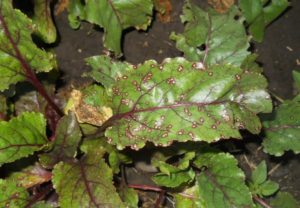
- Scab - manifests itself in the form of growths on the peel of root crops. Means of prevention and control are similar (Fitosporin, Gamair, Trichodermin).
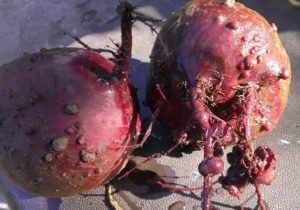
- Fomoz - another fungal disease somewhat similar to Cercospora, but the spots in this case are larger and yellow-brown in color.Methods of prevention and control remain unchanged (Fitosporin, Gamair, Trichodermin).

By the way! Spill the beds Fitosporin (according to the instructions) as a prophylaxis of fungal diseases, it is possible from spring to autumn (i.e. in a warm period of time).
As a rule, pests (beet flies, aphids, nematodes, slugs) very rarely attack beets. Against these pests you can use tobacco dust and wood ash, dusting the beds with them.
Beet harvesting and storage
Naturally, you need to have time to harvest the beets before the onset of frost. Moreover, delaying the deadlines will lead to the accumulation of an excessive amount of nitrates in the root crop, which cannot be allowed. However, you should not rush to harvest the crop either - the beets will not pick up sweetness. Everything must be done on time.
By the way! The site already has an article about when and how to remove beets from the garden for storage.
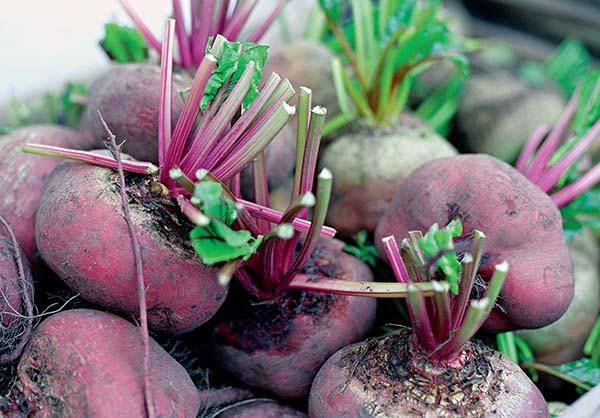
You have collected the crop, now you want to send it to storage.
Important! Find detailed information on ways to store beets after harvest you can in this material.
In fact, even a beginner in gardening is able to grow a crop of sweet and large root crops, which will be perfectly stored until the New Year (or maybe until spring). To do this, you just need to properly care for the beets: timely watering, regular loosening of the soil, removing weeds and feeding them correctly.
Video: how to grow large beets

